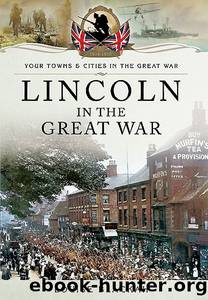Lincoln in the Great War by Louise Blackah

Author:Louise Blackah [Blackah, Louise]
Language: eng
Format: epub
Tags: History, Military, World War I, Europe, Great Britain, General
ISBN: 9781473866195
Google: oZ18DAAAQBAJ
Publisher: Pen and Sword
Published: 2016-08-31T00:21:33+00:00
King George V and Queen Mary visiting the Robey factory. © Lincs to the Past, Lincs County Council
In 1854, Robert Robey established the company after serving an apprenticeship with Clayton and Shuttleworth. The company, like the others, specialized in design, development and manufacture of agricultural machinery.
Following the lead of the other companies in the city, the company went on to secure an Admiralty contract to build seaplanes, and also the Vickers F.B.5, known as the âGunbusâ, a two-seater fighter aircraft specifically designed for air-to-air combat.
Many of the aircraft that flew out of Lincoln to their new Squadrons sported a unique marking, that of a winged imp. The imp of course, represented the Lincoln Imp as seen on the Cathedral itself. Many flying imps left West Common, all bound for a common mission, and were no doubt recognized by anybody who came from Lincolnshire.
Feeding the nation
When war was first declared, there was a national panic, and shelves in shops nationwide were rapidly cleared as people began to hoard food. Thankfully, there was still a plentiful supply of food across the country for quite some time. The Germans did target some merchant ships, and these were often sunk using submarines. However, it was not until 1916 that food began to become hard to source, and harder still, when in 1917, the Germans began a diligent campaign to starve the British into submission by endeavouring to sink all merchant ships trying to come into the country.
The government had to think of a plan that would ensure the country and its people would stay healthy and therefore productive, despite any restrictions to diet. It was therefore decided that a campaign should begin to encourage people to grow their own food as much as possible, and to encourage landowners, be they large or small, to turn whatever pasture that was not being used for livestock, and surplus land, over to growing produce.
Advertisement and flyers went out across the country encouraging everyone to âdo their bitâ and to cultivate every bit of spare land in order to grow vegetables or fruit, or even to keep livestock such as chickens, or perhaps a pig.
In Lincolnshire, as in most households across the country, it was almost a tradition that the man of the house would see to the vegetable plot and the lady of the house have a flower garden, especially to the front of the house, with a small lawn kept with pride. The government was now suggesting that flowers would not sustain a family and that they should be replaced by something more useful. Flower borders were dug up and replanted with potatoes, carrots and other such essentials; those well-kept lawns were dug over and a variety of vegetables planted.
Anyone with a larger garden would have two or three chickens and a cockerel at the end of the garden, which would not only provide a ready supply of eggs, but a hen allowed to brood her eggs could bring off as many as eight to ten chicks, which could be fattened up for the pot, or sold off as âlayersâ to other people.
Download
This site does not store any files on its server. We only index and link to content provided by other sites. Please contact the content providers to delete copyright contents if any and email us, we'll remove relevant links or contents immediately.
The Radium Girls by Kate Moore(11619)
100 Deadly Skills by Clint Emerson(4687)
The Templars by Dan Jones(4556)
Rise and Kill First by Ronen Bergman(4543)
The Doomsday Machine by Daniel Ellsberg(4243)
The Rape of Nanking by Iris Chang(4021)
Killing England by Bill O'Reilly(3896)
Hitler in Los Angeles by Steven J. Ross(3797)
Stalin by Stephen Kotkin(3724)
12 Strong by Doug Stanton(3418)
Hitler's Monsters by Eric Kurlander(3161)
Blood and Sand by Alex Von Tunzelmann(3055)
Darkest Hour by Anthony McCarten(3017)
The Code Book by Simon Singh(2855)
The Art of War Visualized by Jessica Hagy(2836)
Hitler's Flying Saucers: A Guide to German Flying Discs of the Second World War by Stevens Henry(2621)
Babylon's Ark by Lawrence Anthony(2427)
The Second World Wars by Victor Davis Hanson(2419)
Tobruk by Peter Fitzsimons(2373)
